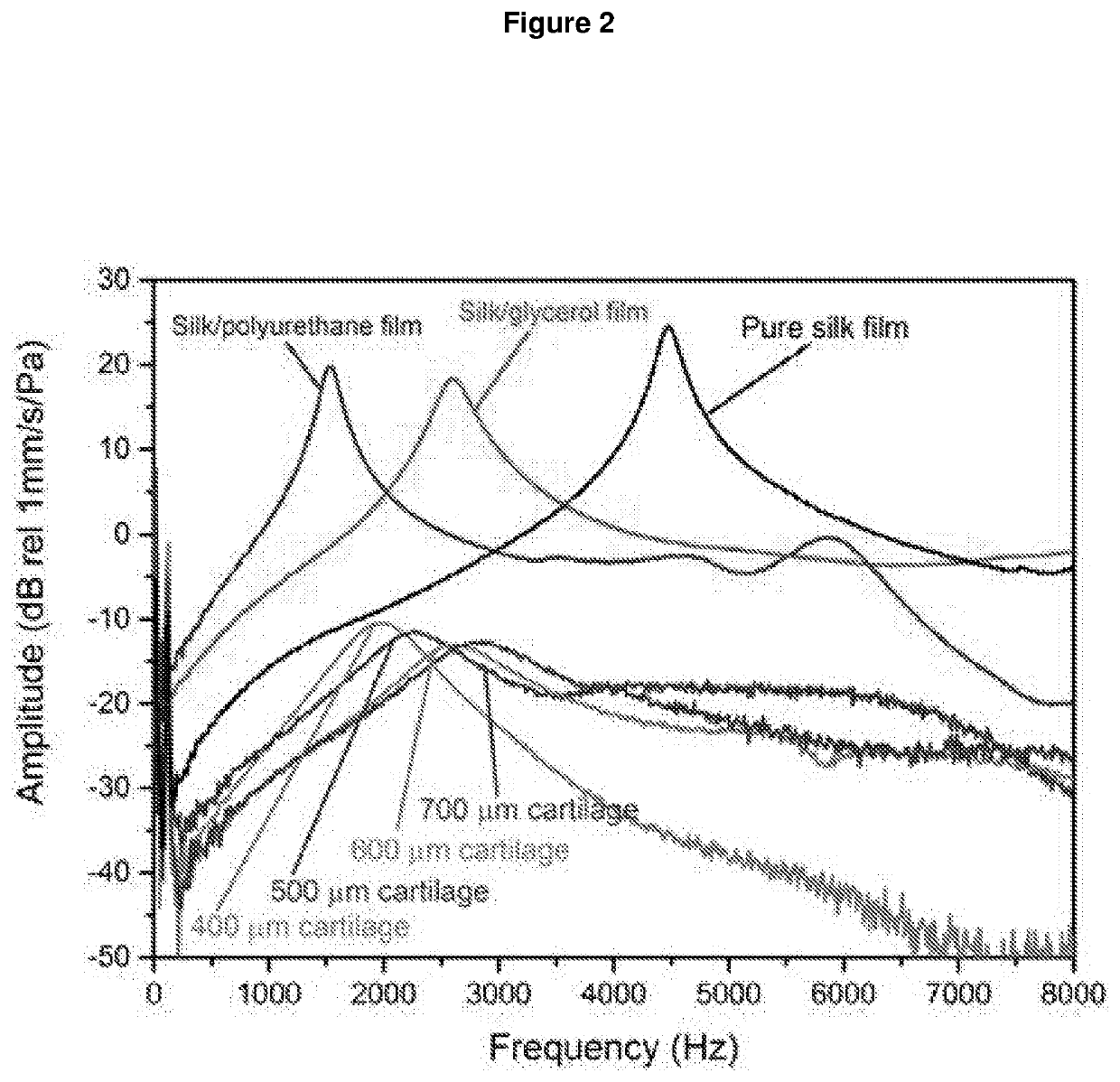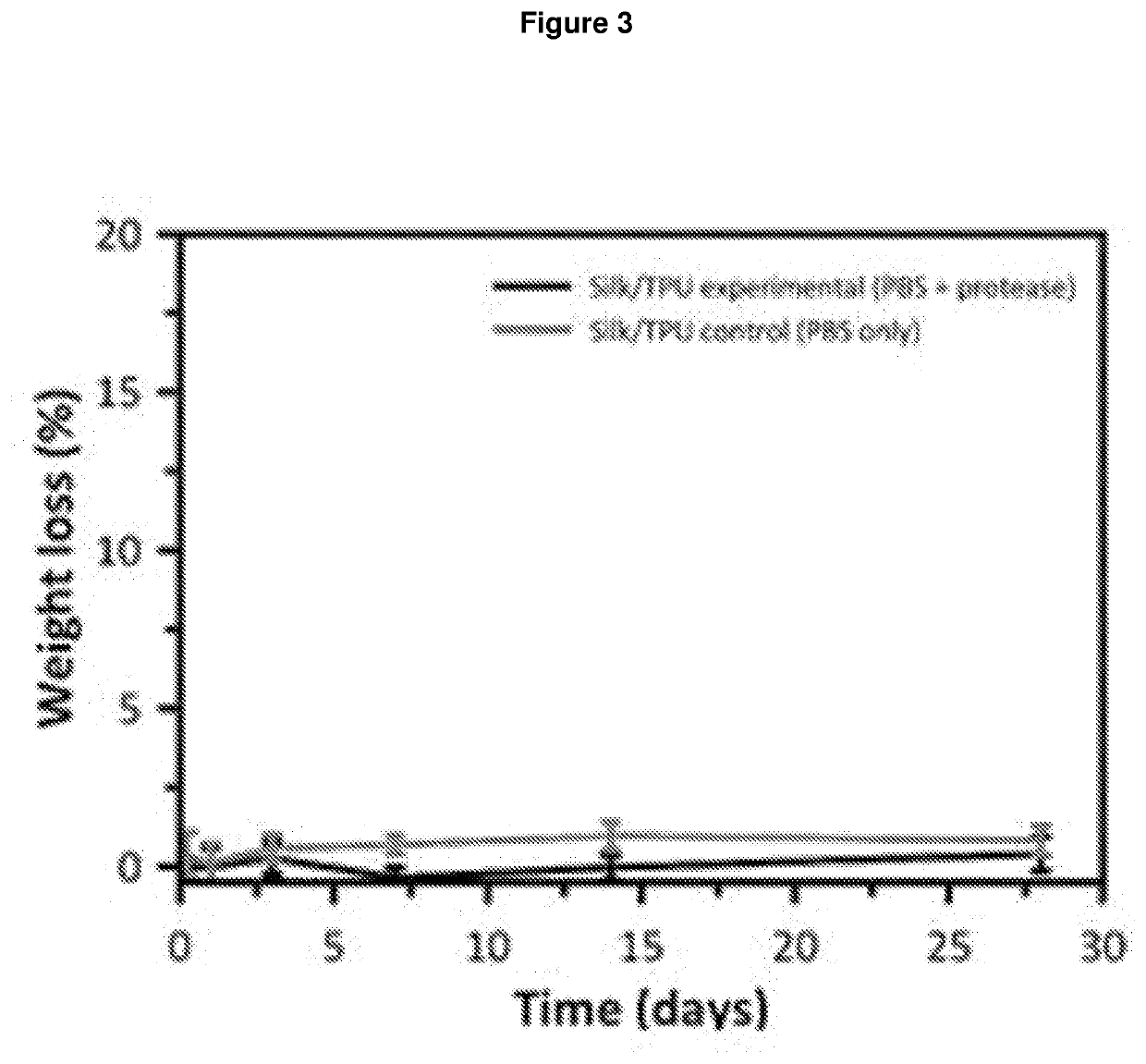Improved silk fibroin biocompatible polyurethane membranes
a biocompatible polyurethane and silk fibroin technology, applied in the field of membrane preparation, can solve the problems of film shrinkage and distortion, matrix agent like a biocompatible polyurethane silk is not soluble in water, and achieve the effects of enzymatic degradation rate, mechanical and vibroacoustic characteristics, strength and flexibility of silk fibroin membranes
- Summary
- Abstract
- Description
- Claims
- Application Information
AI Technical Summary
Benefits of technology
Problems solved by technology
Method used
Image
Examples
embodiments
[0066]Silk fibroin membrane matrixes produced according to the invention are biodegradable, biocompatible, and are improved in one or more of their mechanical strength, elongation and stiffness compared to most other natural and synthetic biomaterials such as collagen and polylactic acid (PLA).
[0067]A. Silk Fibroin Membrane Matrix
[0068]The present invention provides for a silk fibroin biocompatible polyurethane membrane matrix. Membrane matrixes of the invention exhibit higher ductility than silk films lacking biocompatible polyurethane.
[0069]Membranes of the invention are fabricated for repair of tympanic membrane perforations, in particular a chronic perforation. In addition, or in the alternative, membranes of the invention may be fabricated for repair of the ear canal, in particular the pars flaccida and / or the scutum bone of the subject. Preferably, the membrane is fabricated to deliver a device suitable, inter alia, for repair of a tympanic membrane.
[0070]In a first aspect the...
example 1
Preparation of Silk Foam
[0253]Reeled, undegummed fibres from multivoltine Bombyx mori silkworms were purchased from production centres in Northeast India. Fibres were degummed for 30 min at 98° C. using 2 g / L sodium carbonate (Sigma-Aldrich, St. Louis, Mo., USA), and 1 g / L unscented olive oil soap (Vasse Virgin, Wilyabrup, Western Australia, Australia). Degumming was carried out using a rotary dying machine (Ahiba IR Pro, Datacolor, Lawrenceville, USA). Degummed fibres were dried overnight at 40° C. then dissolved with 9.3 M lithium bromide for 5 h at 60° C. Dissolved silk solution was dialysed at 4° C. for 3 days against deionised water (dH2O) to obtain aqueous silk solution with a concentration of between 4 and 5% w / v as calculated by gravimetric analysis. The silk solution from each batch was diluted to 4% w / v, then pipetted into tubes, with 20 mL in each tube. The solution was frozen in a −80° C. freezer for 24 h. The frozen tubes were removed from the freezer, their lids remove...
example 2
Preparation of Blended Silk Fibroin / Polyurethane Membranes
[0254]Freeze-dried silk foam was sliced into small pieces with a scalpel and added to a sterile centrifuge tube together with polyurethane pellets. The two materials were then dissolved in 1,1,1,3,3,3-Hexafluoro-2-propanol (HFIP) for 5 h on a rotary mixer at room temperature. The amount of silk, polyurethane and HFIP used was calculated so that the final concentrations of the two materials were 5% (w / v) polyurethane and 1.25% (w / v) silk fibroin (or 1:4 silk:polyurethane). Dissolved samples were centrifuged at 7000×g for 2 min to remove bubbles, then cast into 55 mm diameter Petri dishes and allowed to dry for 24 h in a fume hood. The final thickness of all membranes was 100 μm.
PUM
| Property | Measurement | Unit |
|---|---|---|
| Fraction | aaaaa | aaaaa |
| Fraction | aaaaa | aaaaa |
| Fraction | aaaaa | aaaaa |
Abstract
Description
Claims
Application Information
 Login to View More
Login to View More - R&D
- Intellectual Property
- Life Sciences
- Materials
- Tech Scout
- Unparalleled Data Quality
- Higher Quality Content
- 60% Fewer Hallucinations
Browse by: Latest US Patents, China's latest patents, Technical Efficacy Thesaurus, Application Domain, Technology Topic, Popular Technical Reports.
© 2025 PatSnap. All rights reserved.Legal|Privacy policy|Modern Slavery Act Transparency Statement|Sitemap|About US| Contact US: help@patsnap.com



